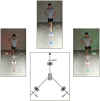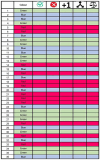Test-retest, intra- and inter-rater reliability of the reactive balance test in patients with chronic ankle instability
- PMID: 38434204
- PMCID: PMC10906270
- DOI: 10.3389/fneur.2024.1320043
Test-retest, intra- and inter-rater reliability of the reactive balance test in patients with chronic ankle instability
Abstract
Introduction: The Reactive Balance Test (RBT) could be a valuable addition to research on chronic ankle instability (CAI) and clinical practice, but before it can be used in clinical practice it needs to be reliable. It has already been proven reliable in healthy recreational athletes, but not yet in patients with CAI who have shown persistent deficits in dynamic balance. The study aimed to determine the test-retest, intra-, and inter-rater reliability of the RBT in patients with CAI, and the test-retest and inter-rater reliability of the newly developed RBT score sheet.
Methods: We used a repeated-measures, single-group design to administer the RBT to CAI patients on three occasions, scored by multiple raters. We included 27 participants with CAI. The study used multiple reliability measures, including Pearson r, intra-class correlations (ICC), standard error of measurement (SEM), standard error of prediction (SEP), minimal detectable change (MDC), and Bland-Altman plots, to evaluate the reliability of the RBT's outcome measures (visuomotor response time and accuracy). It also assessed the test-retest and inter-rater reliability of the RBT score sheet using the same measures.
Results: The ICC measures for test-retest reliability were similar for accuracy (0.609) and VMRT (0.594). Intra-rater reliability had high correlations and ICCs for accuracy (r = 0.816, ICC = 0.815) and VMRT (r = 0.802, ICC = 0.800). Inter-rater reliability had a higher ICC for VMRT (0.868) than for accuracy (0.690).
Conclusion: Test-retest reliability was moderate, intra-rater reliability was good, and inter-rater reliability showed moderate reliability for accuracy and good reliability for VMRT. Additionally, the RBT shows robust SEM and mean difference measures. The score sheet method also demonstrated moderate test-retest reliability, while inter-rater reliability was good to excellent. This suggests that the RBT can be a valuable tool in assessing and monitoring balance in patients with CAI.
Keywords: ankle injury; functional performance test; neurocognitive performance test; reproducibility; screening.
Copyright © 2024 Maricot, Lathouwers, Verschueren, De Pauw, Meeusen, Roelands and Tassignon.
Conflict of interest statement
The authors declare that the research was conducted in the absence of any commercial or financial relationships that could be construed as a potential conflict of interest.
Figures



Similar articles
-
Test-retest, intra- and inter-rater reliability of the reactive balance test in healthy recreational athletes.Phys Ther Sport. 2020 Nov;46:47-53. doi: 10.1016/j.ptsp.2020.08.010. Epub 2020 Aug 23. Phys Ther Sport. 2020. PMID: 32871362
-
Inter-rater reliability and test-retest reliability of the foot posture index (FPI-6) for assessing static foot posture in elderly female patients with knee osteoarthritis and its association with quadriceps muscle tone and stiffness.Front Bioeng Biotechnol. 2024 Jun 21;12:1385986. doi: 10.3389/fbioe.2024.1385986. eCollection 2024. Front Bioeng Biotechnol. 2024. PMID: 38983600 Free PMC article.
-
Reliability, Validity, and Minimal Detectable Change of Balance Evaluation Systems Test and Its Short Versions in Older Cancer Survivors: A Pilot Study.J Geriatr Phys Ther. 2016 Apr-Jun;39(2):58-63. doi: 10.1519/JPT.0000000000000047. J Geriatr Phys Ther. 2016. PMID: 25695466
-
Reliability of the test of gross motor development: A systematic review.PLoS One. 2020 Jul 16;15(7):e0236070. doi: 10.1371/journal.pone.0236070. eCollection 2020. PLoS One. 2020. PMID: 32673358 Free PMC article.
-
Test-Retest Reliability of Five Times Sit to Stand Test (FTSST) in Adults: A Systematic Review and Meta-Analysis.Biology (Basel). 2021 Jun 9;10(6):510. doi: 10.3390/biology10060510. Biology (Basel). 2021. PMID: 34207604 Free PMC article. Review.
Cited by
-
The clinical effects of pulsed electromagnetic field therapy for the management of chronic ankle instability: a study protocol for a double-blind randomized controlled trial.Trials. 2024 Dec 3;25(1):808. doi: 10.1186/s13063-024-08639-z. Trials. 2024. PMID: 39627831 Free PMC article.
References
LinkOut - more resources
Full Text Sources

